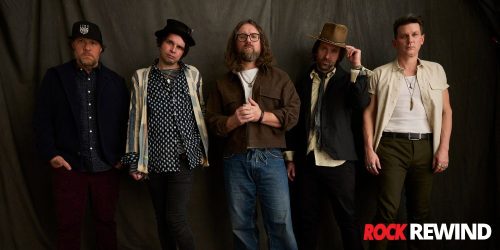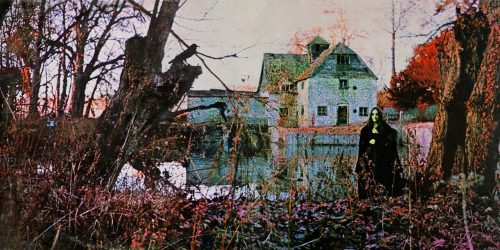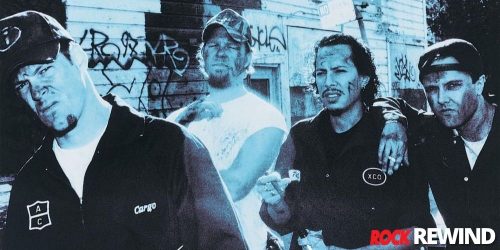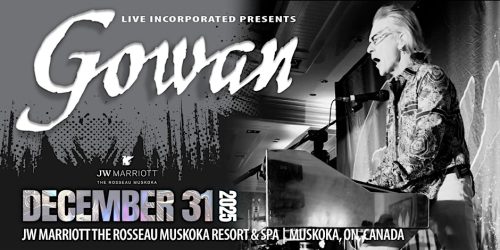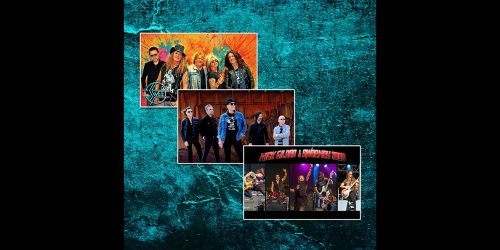Rock Rewind: Alice Cooper The Godfather Of Shock Rock
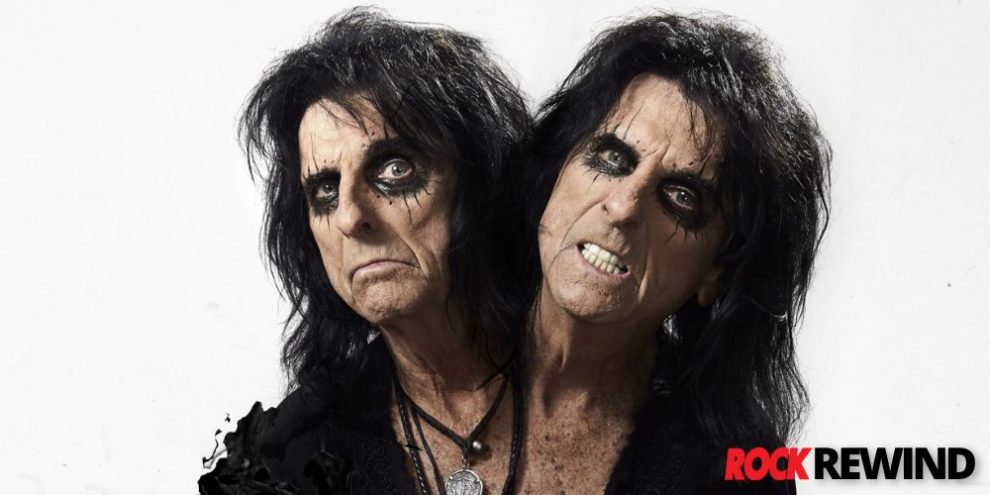
Alice Cooper was born in Detroit Michigan as Vincent Damo Furnier. After starting his first band at the age of 16, his career quickly took off. Today, this American rock icon is known for his theatrical stage performances, which led him to become the "Godfather Of Shock Rock."
Over the past 5 decades, Alice Cooper has had a huge impact on rock n' roll. All of which started with a talent show band called the Earwigs.
So, let’s dive in and take a look at Alice Cooper the band and Alice Cooper the man.
One Band, Many Names
In 1964, Furnier was 16 and living in Phoenix, Arizona with his family. He and four of his cross country teammates formed a band called the Earwigs for the sole purpose of performing in their high school talent show. During the show, they wore costumes and wigs to look like the Beatles and had a set list that included several Beatles parodies.
Of the 5 band members, only one knew how to play an instrument. The other four, including Furnier, pretended to play. Still, the Earwigs walked away with 1st prize.
The groups talent show win inspired them to start a real band. They headed to a local pawn shop to pick up instruments and began learning how to play.
The band soon changed their name to the Spiders and their line up included:
- Vincent Furnier (Alice Cooper) on vocals
- Glen Buxton on lead guitar
- Dennis Dunway on bass guitar
- John Tatum on rhythm guitar
- John Speer on drums
In 1966, the Spiders finished high school. Tatum was replaced by Michael Bruce and the band released their single, “Don’t Blow Your Mind”. It became a local hit.
By 1967, the band had changed their name to Nazz and was regularly travelling to LA for shows.
Under their new name, they released the single “Wonder Who’s Lovin’ Her Now.” It was around this time that Neal Smith replaced John Speer on drums and the band relocated to LA.
In 1968, the band learned that Todd Rundgren (of Utopia) had a band called Nazz. After some discussion, the group decided on Alice Cooper. They thought the wholesome name was a humorous contrast to the band’s music and image.
It was then that the band, known as Alice Cooper was born.
Alice Cooper Gets A Manager
The original Alice Cooper line up was made up of:
- Vincent Furnier (Alice Cooper) on vocals
- Glen Buxton on lead guitar
- Dennis Dunway on bass guitar
- Michael Bruce on rhythm guitar
- Neal Smith on drums
The band continued to play shows under the name Alice Cooper. Following one incredibly unsuccessful show, music manager Shep Gordon approached the band. Even though they had cleared out the venue in 10 minutes, Gordon saw the potential. He arranged an audition for Alice Cooper with Frank Zappa. The renowned record producer’s newest label, Straight Records, was looking for bizarre musical acts.
The audition was at 7 o’clock. Zappa had meant 7 PM but Alice Cooper assumed he meant 7 AM. Zappa was impressed that a band playing such a unique genre of music was waking him up at 7AM. He signed them on for a 3 album deal.
BONUS FACT: GTO, another Zappa band, played a major part in Alice Cooper's on stage look. Especially Miss Christine who dated Furnier in the late 1960s.
Following the 1969 release of Alice Cooper’s debut album, Pretties For You, the band performed at the Toronto Rock Revival concert. It was here that the band had their first major claim to shock rock fame.
How Alice Cooper Became The Godfather of Shock Rock
Furnier always believed that the group needed a gimmick to stand out among bands that were not prioritizing showmanship. But their first big shock rock story happened by accident.
Alice Cooper was performing for the Toronto Rock and Roll Revival at Varsity Stadium. Somehow, a chicken made its way onto the stage during the show. Assuming that chickens could fly, Furnier threw it into the crowd. Instead of flying away, it plummeted into the first couple of rows and was torn apart. At least according to Furnier.
In a 1991 interview, he explains, “That was our very first big show … And you know, the funny thing about the Toronto show was that we had no chickens planned at all; the chickens were thrown by the audience.
“We were on stage, we had feathers, we had pillows and we had CO2 cartridges. We used to break these open and then we would blast feathers all over the audience.
“And then somebody threw a chicken on stage. A live chicken. I was absolutely, I mean, I’m from Detroit, you know, I was never on a farm in my life. I figured, well, it’s got wings, it’s got feathers, it’ll fly. I’ll just throw it out there and it will fly away. I threw it in the audience, and the audience tore it to pieces!”
The story that made front page news following the show was that Furnier had ripped off the bird’s head and drank its blood. Zappa called him to ask if the reports were true but Furnier denied them. Zappa replied, “Well, whatever you do, don't tell anyone you didn't do it.”
Alice Cooper’s blend of glam and stage theatrics would soon grab the attention of the masses ... but not quite yet.
Alice Cooper Continues The Theatrics
Even with all the publicity they got from the chicken incident, the band's second album was a flop. It was around this time, in 1970, that the band moved to Pontiac, Michigan. The Midwestern audiences received their stage act much better than Californians.
In an interview with Metro Times, Furnier explained, “LA just didn’t get it. They were all on the wrong drug for us. They were on acid and we were basically drinking beer. We fit much more in Detroit than we did anywhere else – and on top of that I was from Detroit.”
From 1971 to 1973, the band released 5 more albums and went on multiple tours with increasingly violent stage shows. The performances included theatrics like:
- Mock fights
- Gothic torture
- Staged executions by electric chair
- Guillotine and gallows
- Pyrotechnics
- Reptiles
- Chopping up baby dolls
“We were into fun, sex, death and money when everybody was into peace and love. We wanted to see what was next. It turned out we were next, and we drove a stake through the heart of the Love Generation.”
— Alice Cooper, In The Death Proclamation of Generation X: A Self-Fulfilling Prophesy of Goth, Grunge and Heroin
Alice Cooper Goes Solo
In 1974, the band decided to take a break. Their most recent album, Muscle Of Love, hadn’t reached the same level as Billion Dollar Babies and the band was starting to have regular disagreements.
Gordon explained, “Everyone decided they needed a rest from one another. A lot of pressure had built up, but it's nothing that can't be dealt with. Everybody still gets together and talks.”
The hiatus was expected to be temporary but in 1975, Cooper returned as a solo artist. By this time, he had legally changed his name to avoid legal issues.
Alice Cooper Discography
Since 1975, Alice Cooper has put out:
11 live albums – The Alice Cooper Show (1977), Toronto Rock ‘n’ Roll Revival 1969 Volume IV (1982), Live At The Whiskey A Go-Go (1991), A fistful Of Alice (1997), Brutally Live (2000), Live At Montreux 2005 (2006), Extended Versions Live (2007), Theater Of Death: Live At Hammersmith 2009 (2010), No More Mr. Nice Guy: Live (2012), Raise The Dead: Live From Wacken (2014), and A Paranormal Evening At The Olympia Paris (2018)
17 compilation albums – School Days: The Early Recordings (1973), Alice Cooper’s Greatest Hits (1974), To Hell And Back: Alice Cooper’s Greatest Hits (1985), Price Of Darkness (1989), The Beast Of Alice Cooper (1989), Classicks (1995), A Nice Nightmare (1997), Freedom Of Frankenstein: Hits & Pieces 1984-1991 (1998), Super Hits (1999), The Life And Crimes Of Alice Cooper (1999), Mascara And Monsters: The Best Of Alice Cooper (2001), The Definitive Alice Cooper (2001), The Essentials: Alice Cooper (2002), Hell Is (2002), He’s Back (2003), Poison (2003), School’s Out And Other Hits (2004), Collections (2005), Pick Up The Bones (2007), The Best Of Alice Cooper (2007), Poison: The Best Of Alice Cooper (2009), and Old School: 1964-1974 (2011)
Alice Cooper released 28 studio albums. 7 were as a band and the remaining 21 were solo.
1. Pretties for You (1969)
Pretties For You was the Alice Cooper band’s debut album. While the album was hardrock, the band hadn’t yet found the sound they were known for. It also featured some psychedelic and experimental rock along with songs that have a more Pink Floyd influence.
The album is mostly rehearsal recordings, with the exception of “Levity Ball”, which was recorded live. There was no producer for the album and Zappa left his brother in charge of recording. In fact, Gordon shares that Zappa “didn't spend 5 minutes in the studio” and never asked to hear the material.
The album ended up being a critical and commercial flop though it did appear on the Billboard Top 200 for a very short time. It did, however, win an award in Germany for Best Arranged Album of 1969.
After their third album release, the band would cease to play songs from Pretties For You at live shows.
2. Easy Action (1970)
Easy Action was titled after a line from the musical West Side Story. Songs on the album also include West Side Story lines, including the song “Still No Air”.
Easy Action was produced by David Briggs, who wasn’t a fan of the band. Smith recalls, “David hated our music and us. I recall the term that he used, referring to our music, was 'Psychedelic Shit'. I think Easy Action sounded too dry, more like a TV or radio commercial and he did not help with song arrangement or positive input in any way.”
The label didn’t use Briggs’ production tapes. Instead, they used the rehearsal tapes for the album.
It was also a commercial and critical failure and, like their debut album, none of the songs have been played live since the release of their third album. The only exception being “Return Of The Spiders”, which was played on the third album tour.
3. Love It to Death (1971)
Following the release of their second album, the band moved to Michigan. Locals were more accustomed to wild performances thanks to the proto punk scene.
In November 1970 Alice Cooper released their single “I’m Eighteen”, which peaked at #21 on the Billboard Hot 100. Its success led to the release of Love It To Death in March 1971.
Love It To Death was the band’s breakthrough album, reaching 35 on the Billboard Top 200. It was also the third and last album with Straight Records. Bob Ezrin replaced Briggs to produce the album and became pivotal to helping the band find their sound.
Following its release, Warner Bros. Recording bought out Alice Cooper’s contract and re-issued the album. But this time it got more promotion.
4. Killer (1971)
Alice Cooper continued their success with the release of Killer later the same year. The album made it to #21 on Billboard 200 and “Under My Wheels” and “Be My Lover” both made it onto the Billboard Hot 100.
Lester Bangs from the Rolling Stone said the album “brings all the elements of the band's approach to sound and texture to a totally integrated pinnacle that fulfills all the promise of their erratic first two albums.” He went on to say that Alice Cooper is "a strong band, a vital band, and they are going to be around for a long, long time."
5. School's Out (1972)
The next spring, Alice Cooper released the title single “School’s Out” from their fifth studio album. It charted at #7 in the US and #3 in Canada. In the UK it attracted the attention of parliament, as well as teacher and activist Mary Whitehouse.
Whitehouse ended up convincing the BBC to remove the “School’s Out” from their lineup. But the song still made it to #1 on the UK charts. In appreciation for helping with their publicity across the pond, Alice Cooper sent Whitehouse flowers.
The album was released two months later, reaching #2 in the US and #1 in Canada. In the UK, it reached #4.
6. Billion Dollar Babies (1973)
Billion Dollar Babies became Alice Cooper’s greatest commercial success, reaching #1 in the US and earning platinum status.
In 1973, Furnier shared, “The whole idea behind the Billion Dollar Babies album was exploiting the idea that people do have sick perversions.”
In an interview with Chron, he also shares that the album was a joke about the band. “To us there was always a veiled joke in everything we did. Billion Dollar Babies was a joke about us. How could we, this band that two years ago was living in the Chambers Brothers' basement in Watts, be the No. 1 band in the world, with people throwing money at us. Billion Dollar Babies was about ... realizing we didn't belong there, but knowing it was great to be there.”
The accompanying tour broke US box office records, moving Rolling Stones to second place. It was also the first show with magician James Randi working on design. Props for the tour included:
- 300 baby dolls
- 22,000 sparklers
- 58 mannequins
- 6,000 mirror parts
- 14 bubble machines
- 28 gallons of bubbles
- 250,000 packs of bubble bath
- And more
By this time, more and more politicians and groups were trying to get the band’s shows and songs banned. But most of this only furthered the band's success by creating more publicity.
7. Muscle of Love (1973)
The band’s 7th and last album was released in November 1973. The album had a much different sound to the previous 2 releases.
In a Circular Magazine interview, Furnier explained, “It's not complicated in any sense and there's not a lot of theatricality on it. It's very basic rock and roll throughout … Billion Dollar Babies was a studio effort all the way. So was School's Out. It was just so clean that after a few times of hearing it myself, it had no mystery to it. I really wanted this one to have more guts to it. More balls.”
While recording the album there were some tensions. The band split with Ezrin during one of their rehearsals when Bruce refused to change the arrangement in “Woman Machine”.
Buxton also didn’t play on the album. Smith explains that Buxtons absence resulted from “"problems that Glen was having with the demons of rock and roll at that particular time”
In an interview Dunway recalled, “The problems on that album were that we could tell that everything was being pulled out from underneath us. As hard as we tried to get it back to where it once was, we had that sinking feeling going on. We wanted to rekindle what the band was about but there was just too much exhaustion by then.”
The following spring, the band played their last concert before going on their hiatus.
8. Welcome to My Nightmare (1975) - The First Solo Album
In 1975, Furnier returned to the music scene with his name legally changed to Alice Cooper. In an interview, Cooper explained his solo return.
"It got very basically down to the fact that we had drawn as much as we could out of each other. After ten years, we got pretty dry together."
Produced by Ezrin and backed by Lou Reed’s band, Cooper’s debut solo album, Welcome To My Nightmare, was a success. The concept album follows the journey of Steven through his childhood nightmares. In the US, the album peaked at #5 on the Billboard 200 and was certified platinum. It’s lead single “Only Women Bleed” was a ballad that reached Top 20 in the US.
The accompanying stage show was Cooper’s most theatrical performance and included an 8’ cyclops. The album also led to a television special and a concert film produced by David Winters from the West Side Story cast.
9. Alice Cooper Goes to Hell (1976)
The success of Cooper’s solo project inspired him to continue in the direction he was headed. His second solo studio album continued to tell the story of Steven. He also continued to write rock ballads, given the success of “Only Women Bleed”.
His ballad “I Never Cry” was a song about Cooper’s own drinking problems. These problems would later lead him to rehab and have an everlasting effect on his music.
10. Lace and Whiskey (1977)
Lace And Whiskey is a rock album inspired by 1940s and 50s music and movies. “You And Me” was the album’s lead single and was the last of the band’s songs to chart top 10. The album charted but only reached #42 in the US.
Following its release, Cooper went on his King Of The Silver Screen tour, which was later named School’s Out For Summer tour in 1978. The tour included a giant TV that showed choreographed sequences during songs and mock commercials in between.
Between the 1977 and 1978 legs of the tour, Cooper checked himself into rehab for alcoholism at a New York Asylum. At the peak of his illness, it’s believed that Cooper was drinking two cases of Budweiser and a bottle of whiskey each day.
11. From the Inside (1978)
Following his treatment, Cooper released his 4th solo album. From The Inside was another concept album. But this time it told the story of Cooper’s stay at the New York Asylum, with each character being inspired by real people.
The lead single was another ballad called “How You Gonna See Me Now”. The song peaked at #12 and the album was supported by the Madhouse Rocks Tour in 1979 that included a stage show set in an Asylum. Most of the album’s songs were played on the tour but they’ve rarely been performed since.
The album was also adapted into a Marvel Premiere comic book, which tested out concepts to see if there was an audience.
12. Flush the Fashion (1980)
Over the next couple of year’s Cooper worked on side projects. This included an appearance on The Muppet Show where he played a henchman of the devil who was trying to buy Kermit, Miss Piggy and Gonzo’s souls. He appeared in two films, Sextette and Sgt. Pepper’s Lonely Hearts Band, as well as an episode of Lunch With Soupy Sales.
"Being from Detroit, I came home every day and watched Soupy at lunch (Lunch with Soupy Sales). One of the greatest moments of my life was getting pie-faced by Soupy. He was one of my all time heroes."
— Alice Cooper
In 1980, he released Flush The Fashion. Roy Thomas Baker, who had worked with bands like Queen and The Cars, produced it. While still rock and roll, the album also featured a new wave sound. It made it to #44 on the US charts and it’s lead single “Clones (We’re All)” made is to #40.
RELATED: The story behind Queen and how they continue to inspire ...
According to Cooper, all the track titles were taken from National Enquirer headlines.
13. Special Forces (1981)
Special Forces saw another new producer. This time Cooper worked with Richard Podolor, producer for Three Dog Night.
This album was also the first of three albums that Cooper calls his “blackout” albums. By this point, he was heavy into drugs and had no recollection of recording or touring any of them.
In an interview with The Quietus, Cooper explains, “I wrote them, recorded them and toured them and I don’t remember much of any of that.” In fact, he remembered so little he doesn’t remember that the Special Forces tour was also the last for nearly 5 years.
14. Zipper Catches Skin (1982)
In an attempt to keep up with changing music preferences, Cooper experimented with pop rock and new wave in his seventh solo album.
In a 1983 interview with Hit Parader, Cooper shares that the album is “totally kill. Real hardcore. The stuff that I do has always been a lot like that. In fact, I invented a couple of songs that were remakes of other songs, just for the purpose of attacking clichés. There are no clichés on this album, and I did that for a specific reason. Rock and roll right now is jammed with clichés.”
His longtime guitarist, Dick Wagner, left part way through recording. He described the sessions as a "drug induced nightmare."
The single “I Am The Future” was the theme song for Class Of 1984 and Patty Donahue appeared in the “I Like Girls” music video. Even still, the album was the first since Easy Action not to chart.
15. DaDa (1983)
Dada was the last of Cooper’s “blackout” albums before sobering up and re-emerging in 1986. Cooper recorded the album in Buttonville, Ontario with Bob Ezrin, who he had worked with several times in the past.
Like his last, the album failed to chart in the US and none of the songs from Dada have ever been performed live.
Soon after recording the album, Cooper was hospitalized. He had returned to alcoholism and had cirrhosis of the liver. By fall of the same year, Cooper was sober and stable. In February 1994, Warner Bros. dropped Cooper and he became a free agent.
16. Constrictor (1986)
For the next couple of years, Cooper stayed clear of the music business, though he kept working on material. It was during this time that he started collaborations with:
- Joe Perry of Aerosmith
- Andy McCoy of Hanoi Rocks
- Kane Roberts
He also guested at the Grammys, did some acting, reconciled his relationship with his wife and appeared as a guest vocalist on “Be Chrool To Your Scuel” by Twisted Sister.
He eventually signed on with MCA Records and in 1986 he returned to the music business with Constrictor. The album peaked at #59 on the Top 200 and was certified gold in Canada. Returning to a more hard rock sound, the album was heavily inspired by slasher films.
In fact, three of the album's songs were featured in the film Friday the 13th Part VI: Jason Lives. This included “Teenage Frankenstein”, “Hardrock Summer”, and “He’s Back (The Man Behind The Mask)” as the theme song.
Following its release, Cooper went on The Nightmare Returns tour. It was one of the best tours of the 1980s and helped introduce Cooper to a new generation. But that doesn’t mean it wasn’t without controversy. Cooper’s return to graphic performances had politicians in Europe and Germany calling for bans.
17. Raise Your Fist and Yell (1987)
Raise Your Fist And Yell charted #73 on the Billboard Top 200. It continued with the slasher film theme of the last album with Robert Englund making a guest appearance on “Lock Me Up”. Eglund played Freddy Krueger in A Nightmare On Elm Street. Another track, “Prince Of Darkness”, was also briefly featured in the horror film of the same name.
The accompanying tour, Live In The Flesh, included many classics from past performances, including the gallows. Cooper also added new theatrics inspired by horror movies. One included impaling someone with a bike. This performance was born from a scene in Prince Of Darkness where Cooper’s character killed someone in a similar fashion.
Near the end of the tour, in April 1988, Cooper almost died of asphyxiation. During shows, Cooper would regularly pretend to hang himself. While rehearsing the scene for an upcoming show, the safety rope broke.
BONUS FACT: In 1987, Cooper escorted Jake “The Snake” Roberts to the ring at WrestleMania III for his match against The Honky Tonk Man. After Roberts lost, Cooper threw Jake’s snake at Honky’s manager.
18. Trash (1989)
At the end of 1988, Cooper’s contract expired with MCA and he moved to Epic Records. The following year, Cooper released his glam rock album Trash. The album was a success for Cooper and marked as his comeback album.
Produced by Desmond Child, the album reached Top 20 in several countries and sold over 2 million copies. The single “Poison” was Cooper’s first song to make the Top 10 since 1977’s “You and Me”.
AllMusic described it as a "highly slick and commercial yet edgy pop-metal effort that temporarily restored him to the charts in a big way.”
19. Hey Stoopid (1991)
With the success of his previous album, Cooper continued with his glam rock sound for his next release, Hey Stoopid. The problem was, glam rock was on its way out as the grunge scene moved in. This resulted in less success for Hey Stoopid, though it still ranked 47 in the US and Top 10 in many other countries.
The album featured many guests artists including:
- Slash
- Ozzy Osbourne
- Vinnie Moore (UFO)
- Joe Satriani
- Steve Vai
- Nikki Sixx (Motley Crue)
- Mick Mars (Motley Crue)
Over the next couple of years, Cooper guested with some of the biggest bands of the time. He also appeared in Freddy’s Dead: The Final Nightmare and Wayne’s World.
20. The Last Temptation (1994)
In 1994, Cooper released his 13th solo studio album. The Last Temptation was his first concept album since DaDa. It continues to follow the story of Steven as a mysterious showman persuades Steven to join his traveling show. Darren Hirst of Cross Rhythms describes it as “a young man's struggle to see the truth through the distractions of the "Sideshow" of the modern world.”
Like the previous album, The Last Temptation featured big names like Chris Cornell from Soundgarden and Derek Sherinian of Dream Theater.
Author Neil Gaiman (Stardust, The Sandman) also wrote a three part comic book called The Last Temptation. It builds on the story told on Cooper’s album.
21. Brutal Planet (2000)
After the release of The Last Temptation, Cooper moved from Epic to Hollywood Records. According to his assistant, “"Alice was interested in going to Hollywood Records even before 'The Last Temptation' was released because Bob Pfeifer, who originally signed Alice to Epic, was now the President of Hollywood Records. After 'The Last Temptation' was finished, Alice requested that Sony/Epic let him go so that he could make the switch to Hollywood. He just wanted to go where his friends are.”
Throughout the remainder of the 1990s, Cooper toured and worked on other side projects. This included a role on the London cast recording of Jesus Christ Superstar and more.
In 2000, Cooper released a new album that was heavier than his last. Combining hard rock and industrial metal, the album covered several themes from domestic violence for school shootings. Brutal Planet was inspired by the brutality of today’s world and news stories that were current at the time.
22. Dragontown (2001)
Dragontown is a sequel to Brutal Planet with Cooper describing Dragontown as “the worst town on Brutal Planet.”
The album continued with the heavy themes and industrial metal sounds of his last release. It had no singles and Cooper only played four of the album’s songs on the supporting tour.
While Dragontown peaked at #197 on the Billboard Top 200, it made it to #12 on the Top Independent Albums chart.
23. The Eyes of Alice Cooper (2003)
The Eyes Of Alice Cooper returned to his earlier hard rock style. Cooper produced the album along with Andrew Murdock, who’s known for his work with Godsmack.
Murdock ran into the band while they were rehearsing some of their material. While he was normally pretty booked, he had just had a band cancel on him. Available and loving the new material, Murdock decided to work with Cooper.
They produced the album in 5 weeks with a focus on getting back to basics and minimizing overdubs. The result was one of the most classic sounding Cooper albums since Welcome To My Nightmare.
24. Dirty Diamonds (2005)
Cooper’s next album continued with his classic sound but this time there was more variety. Some of the music has a more classic rock vibe while other songs head into a more heavy metal direction. “Saga of Jesse Jane” even has a bit of a country feel to it.
In the albums press release, Cooper explains:
"'Dirty Diamonds' sounds like "Eyes of Alice Cooper" with more polish on it. On 'Eyes...' I wouldn't allow the band to do overdubs. We did everything in the studio: write, record it and put it to bed. I don't want a Queen album or a Def Leppard album that's perfectly recorded. They're terrific, you can't knock those albums, but that's not the sound I'm looking for. I'd much rather have the sound of an early Stones album. This whole album takes you in a lot of different directions, yet it still really sounds like an Alice album. With Steve [Lindsey] we were able to write it, record it and move on to the next song [as well]. He's one of those guys who has the same kind of music pedigree as Ezrin. We were on the same page as far as the kind of music we were talking about."
Dirty Diamonds reached #17 on the Top Independent Albums chart and #169 on the Top 200, making it the best performing album since The Last Temptation.
25. Along Came a Spider (2008)
Cooper’s next album’s planned release date was 2007. While priming the album, Cooper told Billboard that it would be “a real 'Alice' album. Conceptually, it's going to be pretty interesting. Every song is sort of a letter to the police. They think they're investigating it from the outside, but he's actually woven them into the whole thing.”
It wasn’t until 2008 that the album was finally released.
Along Came A Spider is another of Cooper’s concept albums. This time he tells the story of a psychopathic serial killer called Spider who’s plans unravel when he falls in love with his 8th victim.
SPOILER: In a twist of events, listeners learn that Spider is Steven from Cooper’s other concept albums.
Along Came A Spider was Cooper’s biggest commercial success since 1991. The album charted #53 in the US and #19 in Canada. The accompanying tour was touted as “epic” and said to have had “enough fake blood to remake Saving Private Ryan.”
26. Welcome 2 My Nightmare (2011)
In 2010, Cooper went on tour with Rob Zombie for The Gruesome Twosome Tour. He also scored the music for Silas Gore with his daughter and Dick Wagner. And in March 2011, Alice Cooper (the band) was inducted into the Rock and Roll Hall of Fame.
By the end of 2011, Cooper had released his nineteenth solo album. He was originally planning a sequel to Along Came A Spider. But when he brought the idea to Ezrin, he didn't like the idea of a part two to Along Came A Spider.
“I came to Bob with it, and he listened and goes, ‘Eh. I would be more excited if Along Came a Spider was a No. 1 record.’ He wasn’t really into it. Then we started talking about ‘Welcome to My Nightmare’s’ 35th anniversary or something like that, and he said, ‘What if Alice had another nightmare?’ All I was trying to do was get Bob to say, ‘Yeah, I want to produce the album,’ so we found a place where both of us really felt comfortable, and that was doing ‘Nightmare 2.’”
The album hit #22 on the Top 200 and received generally good reviews.
"Every song off of this new record are absolutely noteworthy, and are bound to be stuck in your head for hours. And although voices in your head are a very serious and legitimate medical condition, I think we can make an exception with Alice Cooper"
— Willian Clark, Guitar International
27. Paranormal (2017)
Over the next 6 years, Cooper kept his schedule full. He toured with Iron Maiden, played festivals and events worldwide, appeared in more films and released a covers album. He also formed the Hollywood Vampires to” honor the music of the rock stars who died from excess in the 1970s.” The band was named after a drinking club Alice formed in the 1970s.
In 2017, Cooper released Paranormal. While Cooper didn’t intend for it to become a concept album, it ended up heading in that direction.
“This isn’t the classic paranormal ghosts and UFOs and stuff. Paranormal, actually, if you look at the dictionary means other than normal or next to normal. My career has been paranormal. So, the idea of this record was the fact that we were not going to write a concept [album]. After we got done writing the album, I listened back to it and accidently wrote a concept. That in every single song every character had some sort of paranormal problem. Or some abnormal situation. So, the last thing we put on the album was the title track. I thought the word paranormal kind of glued all these characters and stories together. I wasn’t using it in a classic sense of ghost hunters.”
— Alice Cooper
The album features guest artists like Billy Gibson (ZZ Top), Roger Lover (Deep Purple), and Larry Mullen Jr (U2). It charted #32 in the US, #17 in Canada and Top 10 in many other countries.
28. Detroit Stories (2021)
Cooper’s latest album was Detroit Stories. It’s about his own musical origins and the history of Michigan hard rock. Cooper’s goal was to return to the roots of rock and create real rock and roll music. As a result, you can hear Michigan rock influences and artists throughout the album.
Detroit Stories debuted at #1 on Top Album Sales chart, making it the first chart-topper in the chart's 29 year history. It also ranked #47 on the Top 200, #2 on Hard Rock Albums and #5 on Top Rock Albums in the US.
Alice Cooper has had a busy career. Not only in music but also as a film actor, restaurateur, radio DJ (Nights with Alice Cooper) and celebrity golfer.
While there have definitely been some ups and downs, it is hard to deny the influence Alice Cooper, the man and the band, have had on rock and roll and the shock rock genre.
RELATED: The full history of AC/DC from High Voltage to Power Up ...
Snag Our Newsletter
Hit that button like you’re pressing play on your favourite track. get exclusive content, stories, and news.


